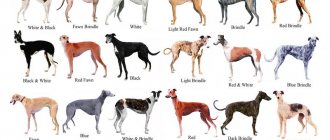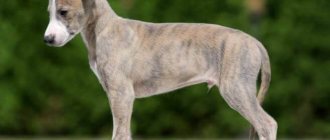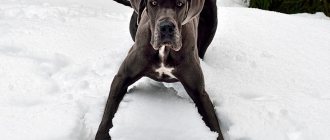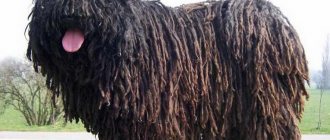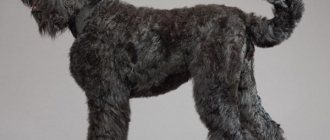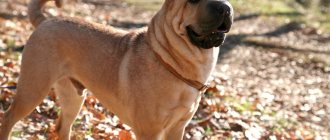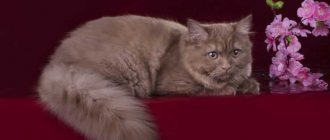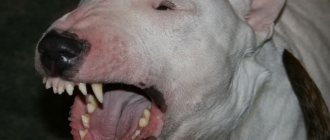The name “mastiffs” unites a large group of breeds, which includes Tibetan, English, French, Spanish, South African, Pyrenean, American, Japanese and other varieties of similar dogs.
There are many rumors about the Fila Brasileiro breed.
It is prohibited in some countries, and in others you simply cannot own a dog without a certain document.
What is special about the Brazilian Mastiff?
Why are there so many prejudices about this breed, and how true are they?
Before getting such a dog, you need to carefully understand everything so as not to be deceived and know exactly what to expect from a Brazilian Mastiff.
Origin story and what it looks like in the photo
It is not known exactly how the Brazilian Mastiff came to be.
At the same time, there are several versions of its origin.:
- According to the first version, this breed was the result of crossing a bulldog, an English mastiff and a bloodhound. This point of view makes sense; it cannot be considered absurd. In the Brazilian Mastiff, the traits of these breeds are indeed visible, and quite clearly. This is visible not only in appearance, but also in other characteristics of the dog.
- The second version says that the ancestors of the Fila Brasileiro are the Molossians brought to Brazil by the conquistadors. Breeds of this variety were mixed with each other, resulting in the Brazilian Mastiff.
How to choose a puppy
A Fila Brasileiro puppy will charm you at first sight, but being touched by this charming creature is by no means a reason for spontaneously purchasing such a dog. Once again, weigh all the pros and cons - decide: are you ready to work hard so that the huge potential inherent in the baby’s genes is revealed correctly and does not cause trouble? If you really feel strong and persistent enough, get a Brazilian Mastiff. You will never regret it and will get a lot of pleasure from communicating with this amazing dog.
Brazilian Mastiff puppies - a gang of cheerful hooligans
Despite its rapidly growing popularity, the breed remains rare and expensive, with a puppy costing between one thousand and two thousand dollars. It is advisable to immediately assess your ambitions and capabilities: whether you want to buy a show dog or just a reliable friend. This decision will determine not only the price of the baby, but also the entire complex of his upbringing in the future - and therefore the rhythm of your life for at least the next decade.
A show-class Brazilian Mastiff puppy is expensive and is socialized from the first months of life.
The task of choosing is greatly simplified by the fact that in Russia and neighboring countries there are already quite a lot of not only Brazilian mastiffs, but also breeding kennels working with this breed. But the very first Fila was brought to Russia relatively recently - in 1992, then the Brazilian Mastiff’s path to popularity began.
So small, but already a pacer
Do not buy a dog from dubious people or resellers - there is a high risk of getting an animal with a disturbed psyche or poor health, or even a mongrel. Try not to choose a baby based on beautiful photographs, but personally come to the kennel for him: evaluate the conditions of keeping and raising him, make sure the adequacy and good health of the parents, find contact with the breeder, whose help you will need more than once, and, finally, see him, your dog. !
Two points will help you make sure of the breed of the puppy you like. Stroke it and pull the skin - kids really like this game. A real Phil should have too much skin, as if he were trying on clothes six sizes too big. Look how the baby runs: only a Brazilian mastiff can have the so-called camel gait - an amble, in which two right paws are alternately rearranged, then two left ones, and so on.
Interesting Facts
- The Brazilian Mastiff is one of the most dangerous breeds in the world due to its hot-tempered and impulsive nature;
- Breeding this breed is prohibited in many countries in Europe and other parts of the world;
- The Brazilian Mastiff is a very loyal dog to its owner. In Brazil there is even a saying: “Loyal as a fila!”;
- The breed first came to Russia in 1922. The first representatives were called Alaketus Dardo and Alaketus Ingrid.
History of the origin of the breed
The history of the breed begins in the 15th century and is closely intertwined with the discovery of Brazil . When the conquistadors arrived on the shores of South America, they brought with them several working breed dogs. These were mastiffs, bloodhounds and bulldogs.
Dogs were needed to protect colonists' settlements, accompany military detachments, drive livestock and hunt jaguar and puma. In addition, with the colonization of Brazil, slavery began to develop, and dogs were needed to monitor slaves and capture fugitives. There were not enough imported and local dogs to perform these tasks. In addition, more resilient, hardworking and strong dogs were required.
Over time, native Indian dogs and native dogs of the Azores interbred with introduced dogs . Some experts claim that the blood of the Fila contains the genes of the Gonka dog, which even then was a cross between a mastiff and a bulldog.
The initial formation of the breed took place without direct human intervention. Later on farms they began to select the dogs most suitable for working qualities and cross them with each other (linear crossing). At that time, little attention was paid to the exterior. Over time, stud books began to be kept on each individual hacienda. And the dogs began to be called fila, which translated from Portuguese means to detain and escort .
The first written mention of the Brazilian Fila breed appeared in 1679 in the book of Rafael de Jesus. And the official history of dogs began in 1938 in Rio de Janeiro at the first Congress of breeders and connoisseurs of this breed, which is also called the Brazilian mastiff. At that time, there were two varieties of phyla: tall with an underdeveloped chest and shorter, but broad-chested. It was decided to breed an average dog while maintaining all its working qualities and basic characteristics . And already at this stage, Brazilian dog handlers got down to business.
After many years of selection, it was possible to obtain a single stable species , the standard of which was described in 1946 by Dr. Paulo Santos Cruz. In the same year, a unified stud book is created, into which data on phyla from all haciendas is transferred. And the doctor himself later became the founder of the first and most famous nursery “Parnapuan”.
In 1960, the breed was recognized by the international canine organization FCI under number 225. These dogs are considered the national pride of Brazil. But due to the low threshold of aggressiveness assigned to the breed, Fila is prohibited in a number of countries for keeping without special permission.
Description of the breed
This breed is very strong and muscular..
The physique is proportional: a large head with floppy ears, a thick neck, a strong body with a deep chest and convex ribs. Under the neck there is a fold of leather.
The eyes are located far from each other and are of medium size . The color of the iris depends on the color of the animal, and can vary from yellow to dark hazel.
If the dog is in a calm mood, the skin falls on the eyes, giving the impression that the dog is sad.
The limbs are smooth and equally muscular; there are no dewclaws on them . The tail is strong and wide at the base. There may be folds on the body, but not on the forehead. Dogs' coat is short and can be of different colors, except black, spots are allowed.
A distinctive feature of the Fila is the “camel step” - they move simultaneously with two limbs of one side. Thanks to this property, representatives of the breed can move with minimal energy expenditure.
Breed standard
The appearance of the Brazilian phylum corresponds to all representatives of the molossoid family. He has a strong bone structure, a rectangular physique, harmonious and proportional. This is an agile and fast breed, despite its heavy forms.
The main distinguishing feature is a large number of skin folds and an eternally sad expression on the face.
Bitches are much more graceful than males; they are inferior to them in both height and weight. According to the standard, the height of adults should be 60-75 cm , weight about 40-50 kg.
On a relatively short, powerful neck with a skin dewlap, a very large, heavy head, proportional to the body, is supported. The ears are V-shaped, drooping, and large in size. The ends are rounded, wide at the base. The skull is wide, slightly convex at the top.
The eyes are almond-shaped and medium in size. The eye color is in harmony with the coat color. Allowed from brown to yellow. Most Brasileiros have drooping eyelids. They contribute to Phil's melancholic image.
The muzzle is voluminous and deep. Slightly shorter in length than the skull. The transition from forehead to muzzle is slight. Almost invisible when viewed from the front. The nose is “Roman”, slightly curved down. The nose is large, black, with well-opened nostrils.
The jaws are powerful. The teeth are strong, wide, sharp. Perfect scissor bite. Pincer bite is not considered a defect.
The body is powerful with a thick, loose skin. The back line is straight. Abdominal line with a slight rise towards the back. The loin is deep and short. The chest is deep, the sternum is well defined.
Medium-set tail. It is wide at the base and gradually narrows towards the end. Quite long, there is a slight bend. When running, in an excited state, the Brasileiro carries its tail high, in this position the bend is clearly visible. It is unacceptable if the tail is rounded over the back.
The bones of the limbs are strong. The rear ones are less heavy than the front ones. The legs are long and parallel.
Paws are oval shaped. Profitable fingers are removed. The paw pads are wide and thick.
The skin is thick, loose, with many skin folds and dewlap.
The coat is short, smooth, and dense. Fits tightly to the body.
The Brazilian Fila can have any color, except white and gray. Brindle color with dark or light stripes is allowed. Minor white markings may be on the chest, tail and paws. Speckled and spotted colors are not acceptable.
Character traits
In relation to Fila, there are different versions regarding her character.
Many breeders and owners claim that the dog is aggressive and can attack a person . There is truth in this statement, because initially the breed was used to guard slaves and livestock.
But the dog never shows unreasonable aggression. She is very suspicious of strangers, but will never attack unless the threat is a threat to her master, whom she reveres and idolizes. Also, the dog will always defend its territory.
Strangers should not come up and just pet a Brazilian Mastiff, he definitely won’t like it . In a family, the dog behaves peacefully and friendly.
It will not offend a child growing up in the house. This breed is also very empathic. She will always feel what the owner needs at one time or another. In difficult times, this dog will always come to express his support.
Also, this breed becomes very attached to only one person in the family . For the Fila, the owner is the authority and the only one who deserves true loyalty and submission.
For this reason, you should not give the dog to other people when it is already accustomed to the family. This could turn into a real tragedy.
Expert opinion
Kozhevin Semyon Kirillovich
Expert dog handler.
“This breed has a very developed watchdog and protective instinct. If someone suddenly wants to enter his territory, the dog will attack without hesitation. He clearly distinguishes “us” from “strangers”. That is why he is always wary of strangers and always expects a trick. In the family circle, with the right upbringing, he will never show anger or aggression, even if he is greatly offended. It’s impossible to call this breed a completely family breed, because you can’t walk with it in a crowded park. But the mastiff loves and protects his household and will never let them be offended.”
Owner reviews
Breeders and owners consider the Brazilian Fila an ideal guard dog, completely devoted to its owner, with developed watchdog qualities and a strong character. To strengthen the bond between the dog and the owner, the pet should be trained not by the dog handler, but by the owner himself, then the Fila will be less aggressive. If you neglect to raise a dog of this breed, the pet will become dangerous to others and even to the owner himself. You need to approach training wisely and have leadership qualities. In good hands, with the right upbringing, this breed will prove itself to be a devoted friend and a wonderful guard.
If properly raised, the Brazilian Fila can be a wonderful friend, protector and nanny, but you should always be careful and not leave children unattended
Advantages and disadvantages
Advantages:
- Will stand up for family members;
- Sensitively guards the territory;
- Loyal to the owner;
- Treats “his” children well;
- Very smart and easy to train;
- Does not require much attention and careful care.
Flaws:
- Absolutely unfriendly to strangers and other people's children;
- Despite easy care, maintenance can cost a pretty penny;
- Stubborn dog, obeys only a person with impressive authority;
- Shows aggression if he sees even the slightest provocation;
- He drools and snores loudly.
Advantages and disadvantages
The Fila Brasileiro is a dog with a complex character and a high degree of aggression . But all hostility and cruelty are directed only towards strangers, who are under no circumstances recommended to approach the dog. Fila dogs show incredible affection and tenderness towards their family . When treated correctly and properly raised, Brazilians show obedience and devotion. The dogs are balanced, calm and good-natured .
But at work, they have no equal in their ability to independently and quickly make the right decision and rush to protect their owners from ill-wishers. Fila considers all strangers to be them, without exception. The dogs are completely unpretentious in keeping and are suitable for apartments and houses.
Pet standard
The International Canine Standard specifies all the necessary signs and characteristics of the Brazilian Mastiff: body build, color, structure of body parts and character. According to the description, this is a Molosser with large bones and a harmonious body build.
The standard specifies the two most important characteristics of Fila Brasileiro:
- The skull is longer than the muzzle;
- The length of the body should be longer by 10% of the dog's height.
The head is massive, with a wide skull, the upper lip covers the lower lip, and is in a drooping state. The forelimbs are more powerful than the hind limbs, the skin hangs freely. The coat is short.
The standard also indicates shortcomings and defects . Some of them include a short muzzle, too light eyes, a sagging or hunchbacked back, weak bones, many white spots on the coat, etc.
Temperament
We can talk endlessly about this beautiful dog. The character of Fila Brasileiro dogs deserves special attention. There is an opinion that dogs of this breed are extremely aggressive and ferocious. There is a rational grain in this statement. Since in ancient times this dog was used to guard slaves, as well as to hunt wild animals, the ability to attack is inherent in its genes.
In many countries, it is simply impossible to purchase this animal without a special license, like for a weapon. Of course, these dogs are extremely distrustful of strangers, but they never attack anyone without reason. A dog can only be provoked into aggressive behavior by the emergence of danger in relation to the owner, whom the dog simply idolizes. The dog treats all family members well and loves small children.
Is it suitable for keeping outdoors and in apartments?
A dog can easily be kept both in an apartment and in a country house, on a plot. She will be equally comfortable, but the site, of course, is the most desirable.
In an open space, the Fila will be able to show the full potential of its security and watchdog qualities . She can be kept in an enclosure, but also allowed to run around the yard, for example, at night, when the house is most in need of protection.
Also, in the fresh air, if possible, the dog will be able to occupy itself on its own, but this does not mean that it does not need to be exercised. Even on the site, you will need to train and train the dog.
If you have chosen an apartment for keeping, then you need to be sure that the dog gets enough hours outside.
NOTE!
Moreover, you need to not only walk with him, but also train him, hone your already learned skills.
This is also important for adaptation, otherwise the Fila will be quite aggressive towards all passers-by, as well as other dogs.
No matter how much you trust your dog, you should only walk it on a short leash and muzzle, except in places where it cannot pose any danger to others.
Contents of Fila Brasileiro
This breed was initially not at all adapted for city life; many generations of its ancestors lived and worked on plantations and large farms. So the modern mastiff yearns for freedom and open spaces. Remember this if you decide to have a puppy of a prestigious and expensive breed in your apartment.
Feeding
Meat for a mastiff is the clear basis of the diet; it should make up about eighty percent of the total daily ration. About one and a half kilograms of fresh red meat (beef, lamb or horse meat) in the daily menu of an adult fillet is the law if the animal is subsistence.
Philos love meat at any age.
In addition to meat, the following products can be sources of animal protein necessary for a dog:
- offal (liver, heart, kidneys and definitely tripe);
- poultry - only without tubular bones;
- fish (sea, boiled, boned) - no more than once a week;
- chicken eggs - 2-3 pieces weekly;
- low-fat cottage cheese and other fermented milk - every other day.
What else can you add and diversify the protein menu for filla:
- vegetables and fruits - except potatoes and citrus fruits;
- fresh leafy greens - unlimited;
- porridge (buckwheat, rice or a mixture of them) - no more than 5 percent of the total food.
And of course, it wouldn’t occur to you to treat your pet with treats from your table - this is a taboo for any dog, like some other foods:
- sweets - especially chocolate;
- fresh baked goods - especially yeast baked goods;
- fresh legumes and dishes made from them;
- Anything smoked, fatty or seasoned with spices.
Breastfeeding mother needs extra nutrition
With a natural diet, the dog must receive vitamin and mineral supplements in accordance with its age and physical condition - discuss their optimal composition and dosage with your veterinarian. It is especially important to properly organize nutrition for growing puppies, pregnant and lactating bitches - filas often have multiple births, and the mother dog must receive a special diet so that there is enough for everyone.
If you prefer to feed your pet with ready-made food and thus solve the issue of nutritional balance, choose high-quality high-protein food for giant breeds from the manufacturers’ lines, for example, these:
- Royal Canin Giant Adult;
- Purina Pro Plan Adult Large Robust OptiHealth;
- Hill's SP Canine Adult Large Breed Lamb & Rice;
- 1st Choice Adult Medium and Large Breeds;
- Acana Adult Large Breed 33/14.
Care and hygiene
The smooth skin of the Fila requires virtually no care - once a week it needs to be massaged with a special mitten or combed with a brush, freeing it from dust, dirt and dead hairs. Frequent bathing for a dog is contraindicated - a couple of bath procedures per year is enough, but swimming in a river or sea is very useful for your pet, and you should not limit it to this.
Well-groomed Brazilian Mastiffs look great
Otherwise, Fila hygiene is the same as for other breeds. It is important to monitor the condition and cleanliness of the eyes, ears and teeth, clean them as necessary and trim the claws if they do not grind down to the required length on the ground.
Training
Don't wake up a "sleeping" dog - most likely this was said about the Fila Brasileiro. Up to six months, puppies behave like any other canine children: they play, explore the world and do not show any particular aggression. But with the onset of puberty, genetics takes its toll - the powerful spirit of stern ancestors awakens in the fillet. Properly directing it in the right direction and constantly monitoring it is the most important task of the owner of such a dog.
How can you not like such a pleated miracle?
You need to start raising and socializing a puppy from the very minute he enters your home - the sooner the better. In a playful form that is understandable to him, rewarding him for obedience, accustom him to the regime and rules of your life, his place in the hierarchy of the new pack. After six months, lessons with a trainer are required - individual or in a group.
Listen, listen, and listen again! Fila must not only complete the mandatory general training course (GTC), but also constantly, every day, consolidate the acquired skills. With perfect obedience, a course in protective guard duty would not hurt - this will help the dog materialize its protective instincts and formalize them into concrete actions.
Fila requires an experienced trainer who knows the breed
An intelligent trainer who knows the breed will under no circumstances set the goal of simply training your dog “out of spite” - the Fila has plenty of his own - but in practice will teach him to work effectively in various emergency situations. Such knowledge does not add aggression to the dog, but confidence in itself and its ability to help its owner. But you should not expect from a Brazilian mastiff the same behavior on the training ground as a German or Malinois - this is a completely different dog, and different approaches to it are needed.
The Brazilian Mastiff encourages the owner to always stay in good shape and be an authority figure for his dog - otherwise he will lose the right to be the leader and give commands.
Attitude towards children and pets
Fila Brasileiro loves children, but only those with whom she grew up, or who grew up next to her . She does not show aggression towards them, she even plays and tolerates their play on her.
But we must remember that there may be a limit to any patience, and leaving a child alone with such a large dog would be reckless and imprudent.
The dog is very wary and suspicious of other people’s children, and can snap and growl, so you shouldn’t let them near the dog or expose them to any risk..
If the socialization stage is completed correctly, the dog will not show aggression towards pets, especially if it grew up next to them.
Small pets are another matter, at the sight of which a dog’s hunting instinct may awaken. We must remember that dogs are different.
Some can quite easily get along with our smaller brothers, while others will not allow the presence of any stranger on their territory or in their home, even if he does not pose a threat.
Purpose of the breed
The main purpose of dogs before the abolition of slavery was to escort and detain slaves . In this the Phils had no equal. They quickly picked up the trail and brought the fugitive back unharmed. In addition, dogs guarded plantations and master's houses , and also served in military units.
In many countries around the world, Brasileiros are used as ideal bodyguards and security guards , as well as in search teams. The breed's secondary purpose is to hunt large game , but these abilities are poorly developed in the dog.
Those who manage to find a common language with Phil acquire in him a reliable and faithful companion.
How to properly care
Caring for a Fila Brasileiro does not require much time or effort, but it is necessary..
- Monitor the condition of your dog's skin. She has short hair. There is no need to bathe often, just use the furminator from time to time;
- Every few days, wash your dog’s folds with a cloth soaked in warm water;
- Every morning you need to wipe your dog’s eyes with chamomile infusion;
- Inspect your dog’s ears; you need to clean them at the end of the week, but not with cotton swabs, but with a special swab;
- Nails need to be trimmed as they grow;
- You need to walk your dog two or three times a day for several hours. Don't forget about certain physical activities: the dog needs to splash out.
If a dog lives in a plot or enclosure, this does not mean that it does not need your attention. Without an owner, the breed quickly withers and becomes lethargic.
Care and maintenance
Caring for the Brazilian Fila is not difficult. Dogs of this breed are unpretentious and clean. Therefore, you can set aside time for a small daily preventive examination, especially of the ears due to their anatomical features.
Also, Fils do not require special coat care. It is enough to clean their short hair with a simple soft brush, and with active shedding, you can use special grooming products for dogs. If suspicious spots are found on your pet, you should show the dog to a veterinarian.
Fila does not require special coat care
According to the recommendations of experts, your pet should be bathed twice a month, not more often. This is due to the fact that the fil sebaceous glands secrete a substance that covers the dog’s skin and protects it from bacteria, insect bites and temperature changes. For prevention, your pet should wipe his eyes daily with an infusion of strong tea leaves and chamomile; by doing this, many infectious diseases of the visual organs can be avoided.
Fila Brazilians are energetic pets that love movement, so you should take into account his needs and try to increase the time for walks. It is worth combining walks and fulfilling the natural needs of the animal, in this way it is possible to accustom the dog to relieve itself outside the house. Phils also love to play a lot with their owner, and the more toys you buy, the more interesting the games will be for your pet. Restricting the dog's movement, especially keeping the Fila indoors around the clock, can lead to the animal interfering with the owner's night's rest: trying to get out of the room, it begins to whine and howl.
Brazilian Fila is a temperamental animal that does not require special care.
How long does one live and the main diseases?
This breed has good health, but there are diseases to which it is susceptible.:
- Hip and elbow dysplasia;
- Digestive problems (bloating);
- Cardiac ischemia;
- Eye diseases (“cherry eye”);
- Otitis.
On average, an animal lives 10-12 years.
Diseases inherent in the breed
Strict selection over several centuries, heavy physical activity in difficult natural conditions - the history of the formation of the breed has contributed to the fact that the modern Fila Brasileiro is a very healthy dog; In most cases, there are no complaints about breed genetics either. Representatives of the breed live, on average, about ten years, and are blessed with strong immunity and resistance to infections. However, they also have their weaknesses in terms of health.
Excess body weight in a dog is an additional burden on the joints
Joints
The fashion for an overly heavy, overloaded breed type inevitably entails problems with the joints. Fila Brasileiros can boast of a strong and healthy bone structure, but in recent years, cases of hip dysplasia have been observed in some domestic breeding lines. It is difficult to say for sure what they are caused by: poor heredity or improper cultivation.
When choosing a puppy, look at pictures of the dysplasia of its parents. Discuss with the breeder and veterinarian the correct diet for the baby and when he should be given supplements with glucosamines and chondroitins. If your dog begins to limp, take it to a doctor immediately.
Ears
Fila has large drooping ears, which interferes with the free ventilation of the ear canals and often provokes otitis media. With timely treatment, a strong immune system quickly copes with this disease, and it almost never becomes chronic.
Leather
Like many smooth-haired dogs, Fila has a predisposition to dermatological problems:
- allergies;
- fungal diseases;
- metabolic disorders.
As a rule, skin diseases in Fila can be treated well if left untreated. Preventative measures are also quite simple: feed your dog properly, walk it more and maintain sufficient humidity in the room where it lives.
Nutritional Features
It is recommended to feed this breed natural food. This is the only way she receives the entire set of necessary components. The bulk of the products should contain meat; beef or lean lamb is suitable.
Mastiffs can also be given boiled sea fish without bones, cereals, vegetables, dairy products and fruits as a reward . Dogs also need various vitamin supplements.
Due to possible digestive problems, dogs need to be fed several times a day in small portions. After eating, you need a short break.
Breed characteristics
| Short description | |
| Origin: | Brazil |
| Conditions of detention: | Local area, free enclosure, country house with or without garden |
| Purpose: | Guard dog, fighting dog, companion dog |
| Color: | Red, yellow, brindle, black |
| Wool length: | Short |
| Adult dog size: | The height of the female is 60-70 cm, the male is 65-75 cm; male weight – 64-82 kg, female – 57-73 kg |
| Average life expectancy: | 9-11 years |
| Walk: | Walking twice a day is required when kept indoors; when kept outdoors, walks can be reduced to once. |
| Physical activity needs: | High demands for physical activity (1.5-2 hours of active walking, games, training) |
| Fédération Cynologique Internationale (FIC) classification: | Group 2: Pinschers and Schnauzers, Molossians, Mountain and Swiss Cattle Dogs; section 2: Molossians |
| Puppy price: | Cost – 24,000-80,000 rubles. Without pedigree - 24,000-30,000 rubles, pet class - 45,000-61,000 rubles, breed class - up to 70,000 rubles, show class - up to 80,000 rubles |
How to choose and who is better - a boy or a girl?
When choosing a puppy of this breed, contact only specialized nurseries and breeders:
- Evaluate the puppy's appearance. You can already guess the future dog in it;
- The bones should be strong and without defects, the muzzle should not be too short, the skull should be powerful, the forehead should be wide;
- The upper lip of puppies already hangs over the lower lip;
- The tail should be without bends, moderately long, wide at the base;
- There should not be any bald patches on the fur;
- The mucous membranes of a healthy puppy are clean, without discharge, there is no unpleasant odor, there are no seals around the abdomen;
- An adequate puppy is moderately playful, curious, but in no case aggressive or cowardly.
When choosing a puppy, you also need to pay attention to the dog's gender identification.
CAREFULLY!
Boys are more aggressive, they zealously protect the territory and the owner, and can be indifferent to children.
In this regard, girls are more gentle and affectionate, they are more friendly towards children, and they become very attached to them, as if they were their offspring.
You also need to remember that females are at risk of pregnancy and childbirth, and this is an additional burden for both the dog and the person..
History of the breed
One of the theories of the origin of the breed is considered to be the breeding of the phylum from purebred mastiffs , English bulldogs and bloodhounds. The blood of these breeds gave the Brazilian fillet this appearance: a strong skeleton, folded skin, excellent sense of smell, increased temperament and stubbornness. All these breeds made it possible to use it as a guard dog; it was especially well suited for protecting herds from jaguar attacks and for chasing slaves if they tried to escape.
The second version says that the Brazilian Fila descended from the pre-existing Terceira mastiff dog breed (port. Cao de Fila da Terceira). The breed was named after the island of Terceira and ended its existence in the 1970s.
Fila Brasils were bred to hunt jaguar, and in modern times this breed is an excellent guard dog.
The Brazilian Fila was bred over the course of more than a century, the best animals were carefully selected, and only in the 40s the standard specimen was chosen. In the 70s, the breed was improved, the necessary traits were added that finally formed the dogs of this breed.
Psychological picture
Despite their size, dogs of this breed are very mobile, they move easily, and can change the direction of movement at full speed, practically without slowing down.
A characteristic feature of Phil is his courage, determination and bravery. He is obedient to his master and his entire family, including children, to whom he forgives all pranks. Loving and devoted until the end of his days, he will always seek the company of his master. In Brazil, his devotion became a saying that applies to people - “Loyal like Fila.”
Filas are strongly attached to the owner and members of his family and show exceptional obedience and desire to protect them. You could say they live to protect those they love, including children and pets. He has an incredibly strong instinct to protect both his owner and his territory. However, the Brazilian Mastiff remains an incredibly loving dog. This strong protective instinct creates certain inconveniences, since this dog always has to be kept on a short leash so that some situation does not accidentally provoke aggression.
One of the characteristic features is distrust towards outsiders. However, outside the home he does not show excessive aggression, he behaves confidently, calmly and with a sense of self-esteem.
